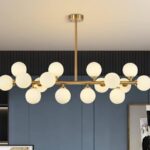Furniture assembly lines are critical to modern furniture production lines, providing efficiency, consistency, and scalability. Be it the chairs in your dining room or the modular sofas in your living room, it likely all came together through some variation of an assembly process. But how did this system come to dominate furniture manufacturing, and why is it so relevant today?
Thank you for reading this post, don't forget to subscribe!This blog delves into the furniture assembly line by tracing its evolution, breaking it down in to its parts, showcasing the tech that drives it, successful implementations and future trends.
That is the Reason Behind Furniture Assembly Lines.
Furniture assembly line is a step by step process or method used to manufacture the furniture on a large scale. Rather than having an artisan make an entire piece of furniture, from start to finish, the work is broken down into stages, with each team or machine performing a specific task.
But Why is the Assembly Line Approach So Important?
Efficiency: It enables manufacturers to create huge amounts of furniture in less time.
Cost-effective: Less dependence on manual labor results in reduced operational cost.
Uniformity: The same process is applied to all products.
Customization: Unlike early assembly lines, modern ones can quickly change to meet customer preferences.
A Brief History of Furniture Assembly Lines
The idea of the assembly line took off in the industrial revolution, but its origins date back even further.
Early Furniture Manufacturing
In the pre-industrial age, furniture was handmade by craftsmen. Each work was one of a kind and might have taken days or weeks to finish. While this bespoke model allowed for high levels of craftsmanship, it found it hard to keep up with growing demand.
The Industrial Revolution
The era of mechanisation in furniture production Started in around 18th century and the end of 19th century. Machines were assigned to particular functions like sawing, sanding, and shaping. The what we call the division of labor was formalized, and the first version of production lines started to take shape.
Mass Production in the 20th Century
At the beginning of the 20th century, spurred by Henry Ford’s advances in automobile production, furniture manufacturers adopted full-blown assembly lines. It was made widely available to the average consumer, making quality furniture accessible at lower prices.
The Contemporary Furniture Assembly Line
Today’s assembly lines are more efficient than ever, thanks to advances in robotics, automation and digital technologies. They use a mix of technology and human supervision to deliver scalable, customizable, high-quality furniture.
Modern Furniture Assembly Line Stages
This saves money at the start, but demands a cost at the end! Here’s a closer look at those stages:
Material Preparation
In this phase, raw materials such as wood, metal, or fabric are cut to the dimensions needed. Cutting-edge equipment like CNC (computer numerical control) machines guarantee precision with each incision.
Component Manufacturing
Table legs, chair backs and drawer panels are shaped, assembled or molded into individual pieces. Step 3: Go to machining (Machines like lathe and molding equipment install this step quickly.
Assembly
Observe how the final product is created by composing the private components based on pre-defined sections Operations such as auto-screw, auto-glue, and auto-nail are either done manually or done via automated robotic arms.
Finishing
The final stage is applying polish, paint or stain to add beauty as well as protect the furniture. Automation affords consistent coverage, while manual finishing allows for detail where needed.
Quality Control
Each piece of furniture is subjected to a strict quality check before it is packaged. Sensors and various applications of artificial intelligence (AI) are the core for discovering issues ranging from scratches and alignments to weak joints.
Packaging and Distribution
The last phase is the packaging of the furniture in such a way that they are safe for transit. Certain assembly lines use machines to manufacture flat-pack solutions for easy transport.

Technology In Furniture Assembly Lines
Innovative technologies are used heavily during furniture assembly at modern companies, increasing both productivity and precision.
Robotics
AI-powered robotic arms are a familiar sight on assembly lines. They are good at repetitive tasks like drilling, welding and painting — with a high level of accuracy.
IoT (Internet of Things)
IoT systems continuously monitor every aspect of the production process. Machine smart sensors produce actionable data on machine performance, helping manufacturers avoid downtime and ensuring a continuous flow of workflow.
Computer-Aided Design (CAD)
In fact, CAD software can be directly integrated into many assembly lines, allowing for live updates to material transitions from design phase to production. Which makes sure all the items meet the required specifications.
Machine Learning and AI
Using data analysis with artificial intelligence, this will then detect patterns and optimize the processes, then apply improvements to the production line. Another major application of AI is predictive maintenance, which helps equipment run smoothly without shocks and surprises in the form of breakdowns.
Automation
From conveyor belts to robotic screw drivers, the world of automation reduces the need for manual work and increases production rates.
Assembly Lines — Challenges & Solutions
No manufacturing process is perfect, however. But all these issues can be addressed on furniture assembly lines with forward-thinking solutions.
Challange 1: Balancing Automation with Craftsmanship
Pure automation can at times supplant the artisanal quality of furniture, and its roots in craftsmanship.
Solution: Set up a hybrid model wherein machines take care of the repetitive jobs while skilled artisans manage the complexities.
Challenge 2: Sustainability Issues
Furniture manufacturing generates a significant amount of waste and has a massive impact on the environment.
Solution: Use recycled stock and implement eco-sensitive processes, including water-based finishes and low-energy machinery.
Challange 3: Downtime and Maintenance
Unexpected failures of equipment can halt production and raise expenses.
Solution: Proactively monitor machine performance with the help of predictive maintenance systems and IoT-powered sensors.
Furniture Assembly Lines That Work — Case Studies
IKEA
So much so that IKEA is a world leader in assembly line. Its furniture designs are for flat-packing, designed — and re-designed after feedback — for production in factories and easy assembly at home. They have invested in automation, which has enabled them to maintain high quality while providing low prices.
Herman Miller
Herman Miller, known for its ergonomic office furniture, employs cutting-edge technologies, such as robotics and CAD software, to manufacture complex designs like the Aeron chair.
Steelcase
Steelcase have found an impressive equilibrium between automation and craftsmanship. Through eco-friendly policies and high-end monitoring tools, the company has improved its efficiency while ensuring sustainability as a key priority.
Furniture Assembly Lines of the Future
Furniture is constantly adapting with exciting new changes on the way.
Sustainable Practices: The use of renewable materials and energy-efficient production methods will only increase.
AI Evolvement: AI will provide insights into customer preferences at a much deeper level and provide the ability to customize products on the assembly line in real-time.
Collaborative Robots (Cobots) – As opposed to traditional robots, cobots will collaborate side by side with human workers, improving efficiency without taking their craft.
At a factory level, factories will undergo complete digitization and will be equipped with IoT systems that will make them smart, which will facilitate seamless operations.
Creating an Efficient Assembly Line
I suppose if we are to discuss a prosaic example, that would truly be furniture assembly line where volume has completely changed furniture. Utilizing technology, expanding efficiency, and tackling challenges through creative solutions enable manufacturers to produce cost-effective furniture that is of high quality and serves consumer needs.
Want to learn more about optimizing an existing furniture assembly line or implementing one in your processes? Reach out to our specialists for a bigger picture on how to establish an agile and future-ready production process.



